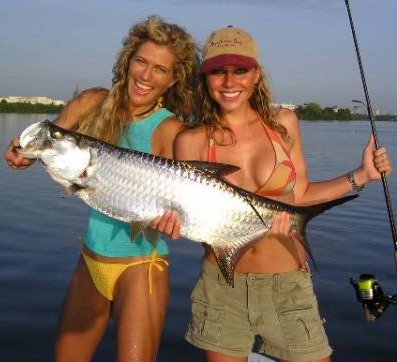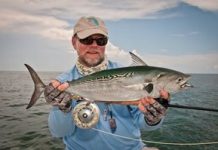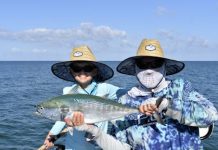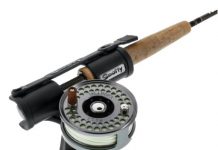By CAPT. PAT DAMICO
 What is my favorite saltwater fish to chase with the long rod? I’m often asked this question. I usually qualify it by saying, “Tailing redfish in shallow water, snook around lighted docks, or baby tarpon.” The first two are more easily available, the last, continues to be a mystery. I have spent a lot of time searching areas for baby tarpon. Many times I am not successful, however I have some trips that have been spectacular. Very little has been published about these smaller silver kings. It seems that most authors want to keep the secrets to themselves. Through the years, my experience has narrowed the search to include several prerequisites for success.
What is my favorite saltwater fish to chase with the long rod? I’m often asked this question. I usually qualify it by saying, “Tailing redfish in shallow water, snook around lighted docks, or baby tarpon.” The first two are more easily available, the last, continues to be a mystery. I have spent a lot of time searching areas for baby tarpon. Many times I am not successful, however I have some trips that have been spectacular. Very little has been published about these smaller silver kings. It seems that most authors want to keep the secrets to themselves. Through the years, my experience has narrowed the search to include several prerequisites for success.
Locating them and catching them are two different problems. If we limit our choice to fly fishing only, we have our work cut out for us. I know where there are several schools of smaller tarpon, up to thirty pounds, that are in the same area year around. The locations have these similar characteristics. They are bays that are away from the main body of water. The water temperature is a little warmer than surrounding locations, usually exposed to a lot of sun. A deep “hole’ is usually present. My fish finder marks tons of small baitfish, probably glass minnows, year around. Warmer water usually indicates a spring may be close to their home. A shallow water entrance may prevent large predators, sharks and dolphins, from getting in. They are here because they have a constant source of food, comfortable water temperature, depth, and safety.
Besides bays, rivers are the next location with some consistency. Remember, they can adapt to fresh water and will sometime be away from salt for the winter months. As temperatures cool, depth seems to become more important. The outside bend in a river is always deeper. If the average depth of a river is five or six feet and an outside bend has a fifteen foot drop, this will be a good place to look. In both bays and rivers, when they are seen rolling in deep water, they are generally not feeding, but taking advantage of their air breathing ability. If the water is somewhat brackish, or stagnant, the rolling will be more frequent. Quickly casting a fly to a rolling fish will occasionally result in a hookup, but I feel most feeding is done closer to the bottom than the surface. The one that takes the fly may be a companion to the rolling fish. They are rarely concentrated and will be spread over a large area. Dr. Aaron Adams, author of “Fisherman’s Coast,” suggests using a weighted clouser with a sinking, or sink tip line to get your offering on the bottom where they are doing most of their feeding. If there is adjacent structure to their home, like a tree that has fallen in the water, cover the area with careful, well presented casts. Baitfish will generally use the tree for cover and tarpon will lurk nearby. This is one time that they will frequent the shallows. If presentations close to the surface are refused, use a weighted fly with a clear intermediate sinking tip fly line.
Fly selection will depend on the size of bait available. In warmer weather, I have seen them chase baits as large as four inches up to the surface in skinny water. Pencil poppers are effective when this happens. In colder weather, smaller flies are more productive. Keys type tarpon flies when downsized as small as size one work well. Expect to miss a lot of small tarpon. Unlike their bigger family members, small tarpon often swirl at the fly, resulting in “short strikes.” A longer shank hook with a large gap will help. When stripping, eliminate slack by keeping your rod tip on the water surface and if you can’t see the fly, watch the end of the fly line for the slightest hesitation. I’ve watched clients miss a take because of slack line many times, especially in brackish or tannin stained water. If seeing the end of your fly line is a problem in stained water, a one foot section of Orange colored Amnesia monofilament, the same diameter as your butt section between the leader and end of the fly line, will give you a strike indicator. This is a trick that I occasionally use when fishing for small mouth bass in rivers.
A recent kayak trip with Chrystal Murray put us into a concentration of very happy tarpon up to twenty pounds. Knowing how much I love to fly rod these juveniles, she contacted me and we ventured into a series of overgrown canals that were full of glass minnows and feeding fish. Our Ocean Kayak’s provided our transportation as well as a fishing platform for our stealthy approach. I jumped many more fish than I landed due to the tight quarters and water laden structure. My new TFO, TiCrX eight weight fly rod was a perfect choice for our trip. This seven and a half foot four piece rod really had a workout. It’s small size made it easy to transport thru some tight spots where mangroves overgrew parts of our waterway. Casting was simplified in tight quarters because of it’s size. It had adequate backbone to, “put the screws,” to the tarpon that ranged into the twenty pound class. My leader was the rod’s length. Five feet of forty pound for the butt section and a thirty pound mason monofil tippet was all that was needed. A 1/0 standard cockroach, an all white keys design, and my bead butt baitfish pattern all seemed to work.
 Depending on your location, it may take some effort to locate these mini silver kings. There isn’t another fish that will give a fly rodder more of a challenge. The antics and commotion that begins when they feel the steel will make them your favorite too.
Depending on your location, it may take some effort to locate these mini silver kings. There isn’t another fish that will give a fly rodder more of a challenge. The antics and commotion that begins when they feel the steel will make them your favorite too.
A FFF, certified casting instructor, Capt. Pat Damico guides fly and light tackle trips in lower Tampa Bay and surrounding waterways. His website www.captpat.com will provide additional information.
- Capiains Corner. Damico - December 26, 2023
- Pat Damico - December 21, 2023
- CaptainsCorner: Pat Damico - November 27, 2023











